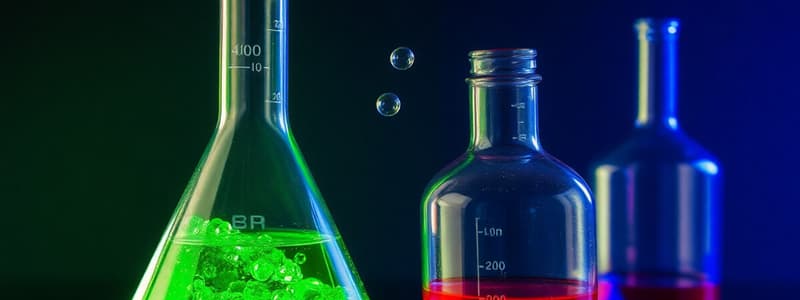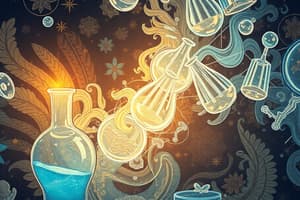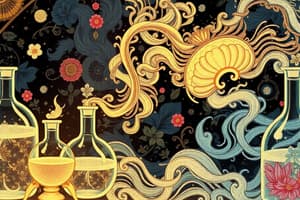Podcast
Questions and Answers
Which process exemplifies a physical change, where the substance's identity remains unaltered?
Which process exemplifies a physical change, where the substance's identity remains unaltered?
- Burning wood, resulting in ash and gases.
- Frying an egg, causing the protein structure to change.
- Melting solid ice into liquid water. (correct)
- Rusting of iron, forming iron oxide.
Which of the following observations most strongly suggests that a chemical change has occurred?
Which of the following observations most strongly suggests that a chemical change has occurred?
- A substance changes shape when hammered.
- A solid dissolves completely in water.
- Bubbles form when two solutions are mixed. (correct)
- A liquid evaporates at room temperature.
Consider a scenario where a metal is heated until it glows. Which observation would definitively indicate a chemical change rather than just a physical one?
Consider a scenario where a metal is heated until it glows. Which observation would definitively indicate a chemical change rather than just a physical one?
- The metal expands in size.
- The metal's density decreases slightly.
- The metal emits light.
- The metal reacts with air, forming a new surface layer. (correct)
A student mixes two clear solutions, and the resulting mixture becomes cloudy and warm. What type of change is most likely occurring?
A student mixes two clear solutions, and the resulting mixture becomes cloudy and warm. What type of change is most likely occurring?
Which of the following processes involves breaking chemical bonds to create new substances?
Which of the following processes involves breaking chemical bonds to create new substances?
Classify the following process: A candle burns, producing light, heat, carbon dioxide, and water vapor.
Classify the following process: A candle burns, producing light, heat, carbon dioxide, and water vapor.
What distinguishes a compound from a mixture at a molecular level?
What distinguishes a compound from a mixture at a molecular level?
Which of the following is an example of a mixture composed of both elements and compounds?
Which of the following is an example of a mixture composed of both elements and compounds?
A chemist observes that when two chemicals are mixed, the solution changes color and the temperature drops significantly. Is the reaction endothermic or exothermic, and is it a physical or chemical change?
A chemist observes that when two chemicals are mixed, the solution changes color and the temperature drops significantly. Is the reaction endothermic or exothermic, and is it a physical or chemical change?
Flashcards
Physical Change
Physical Change
Altering a substance's appearance or state without creating a new substance.
Chemical Change
Chemical Change
A process that forms a new substance with different properties.
Indicators of Physical Change
Indicators of Physical Change
Words like melting, boiling, and mixing describe this type of change.
Indicators of Chemical Change
Indicators of Chemical Change
Signup and view all the flashcards
Element
Element
Signup and view all the flashcards
Compound
Compound
Signup and view all the flashcards
Mixture
Mixture
Signup and view all the flashcards
Examples of Chemical Change
Examples of Chemical Change
Signup and view all the flashcards
Reversibility in Changes
Reversibility in Changes
Signup and view all the flashcards
Combination example
Combination example
Signup and view all the flashcards
Study Notes
Physical vs. Chemical Change
- A physical change alters a substance's appearance or state without forming a new substance. It is reversible.
- A chemical change forms a new substance with different properties than the original ones. It is not reversible.
Identifying Physical Changes
- Often described by words like: melting, evaporation, boiling, condensation, crystallization, mixing, crushing, etc.
Identifying Chemical Changes
- Often indicated by: changes in energy (light, heat, sound), color changes, formation of gas bubbles, changes in taste, density, smell, or temperature.
Distinguishing Features
- Physical Changes: Mostly reversible, no new substances are formed, substances retain their properties.
- Chemical Changes: Not reversible, one or more new substances are formed, the new substances have different properties from the original.
Examples of Chemical Changes
- Baking a cake
- Burning wood
- Digesting food
- Rusting of a nail
- Burning ice cream
- Combining hydrogen and oxygen to form water
- Vinegar and baking soda solution
- Crushing a soda can (physical change)
Examples of Physical Changes
- Melting ice cream
- Crushing a soda can
- Cutting a piece of paper
- Boiling water
- Mixing sand and marbles
Studying That Suits You
Use AI to generate personalized quizzes and flashcards to suit your learning preferences.




